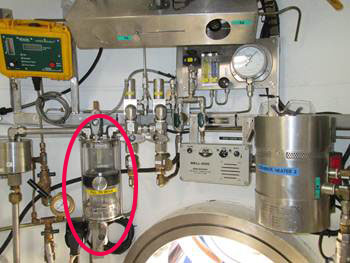Bell re-claim failure resulting in minor injury
A member has reported an incident in which a member of a dive team suffered minor injuries when equipment in a diving bell failed under pressure. The incident occurred during saturation diving operations at 110 msw. The bellman was assisting diver 1 and diver 2 to prepare for diving activities. On opening the reclaim return line hull valve the internal in line water trap was immediately pressurised and ruptured. Perspex fragments of the water trap dispersed inside the bell causing superficial lacerations to the bellman’s left ear and face. The force of the blast caused a small rupture to the tympanic membrane in his left ear. Diving activities were aborted and divers were returned to the living chamber. The injured person was further assessed/treated by the diving medical technician in consultation with a physician ashore and with assistance of the on board medic.


Our member’s investigation revealed the following:
- In 2013 the diving bell underwent refurbishment and total re-build and as part of this process the external check valve was removed and then re-installed;
- The diving bell had made 23 successful bell runs since being refurbished;
- The reclaim compressor solenoid had failed resulting in non-operation of the cross feed actuator, in turn causing pressure to be retained in the exhaust line;
- The bell return line external check valve had been previously incorrectly installed (inverted) during the refurbishment, allowing stored gas in the exhaust line to pressurise the internal in line water trap once the reclaim return line hull valve was opened by the bellman.
The root cause of the incident was determined to be that the check valve was incorrectly installed (inverted). A contributing factor was that the planned maintenance regime did not include increased frequency of filter change since the refurbishment; the reclaim compressor was started remotely.
Our member drew the following lesson:
- During refurbishment and before being certified for use, the saturation system was subject to a number of audits and inspections conducted by third party specialist, client, owner, and project personnel. Each time, the inverted check valve had not been spotted. The audits/inspections were consistent with IMCA and industry requirements, but did not consider the system at the individual component level required to identify the incorrectly fitted check valve.
Members may wish to look at the following incidents involving pressure failure in saturation diving equipment (keywords: pressure, saturation):
Safety Event
Published: 17 July 2014
Download: IMCA SF 13/14
IMCA Safety Flashes
Submit a Report
IMCA Safety Flashes summarise key safety matters and incidents, allowing lessons to be more easily learnt for the benefit of all. The effectiveness of the IMCA Safety Flash system depends on Members sharing information and so avoiding repeat incidents. Please consider adding [email protected] to your internal distribution list for safety alerts or manually submitting information on incidents you consider may be relevant. All information is anonymised or sanitised, as appropriate.
IMCA’s store terms and conditions (https://www.imca-int.com/legal-notices/terms/) apply to all downloads from IMCA’s website, including this document.
IMCA makes every effort to ensure the accuracy and reliability of the data contained in the documents it publishes, but IMCA shall not be liable for any guidance and/or recommendation and/or statement herein contained. The information contained in this document does not fulfil or replace any individual’s or Member's legal, regulatory or other duties or obligations in respect of their operations. Individuals and Members remain solely responsible for the safe, lawful and proper conduct of their operations.
